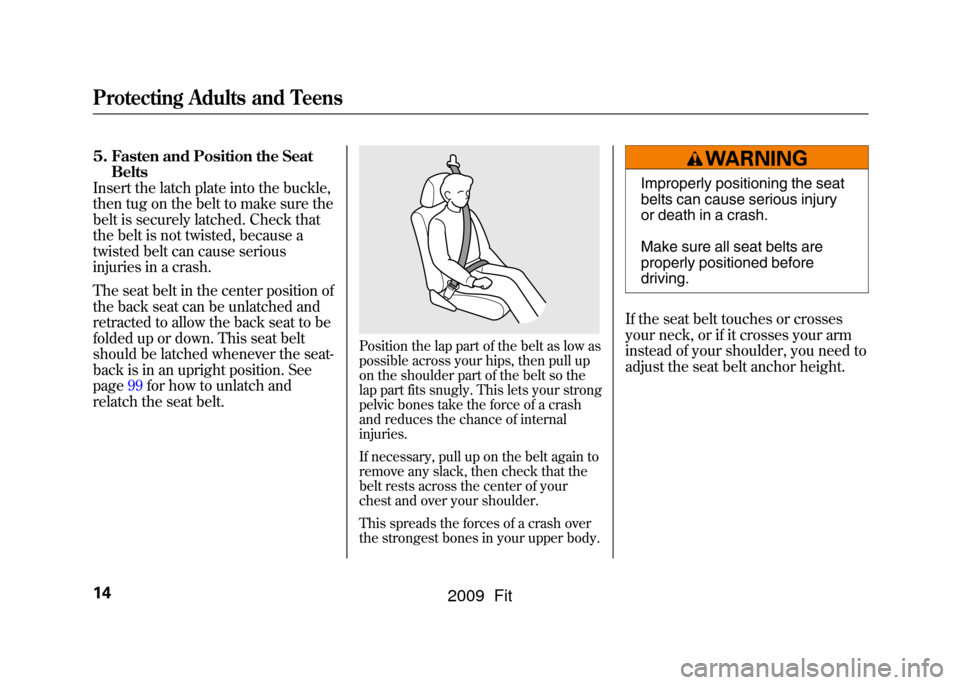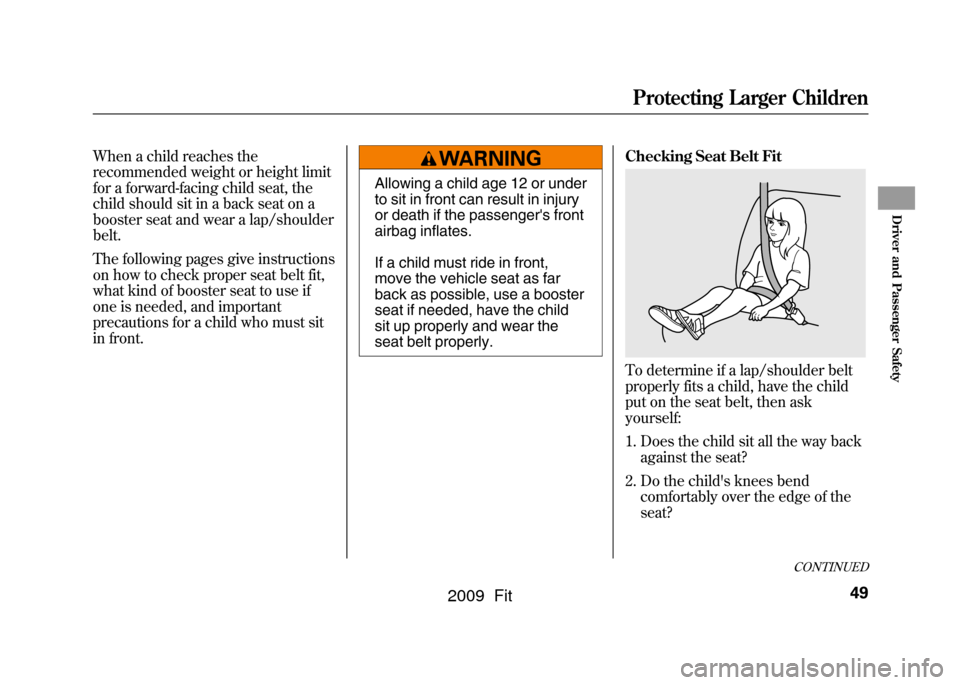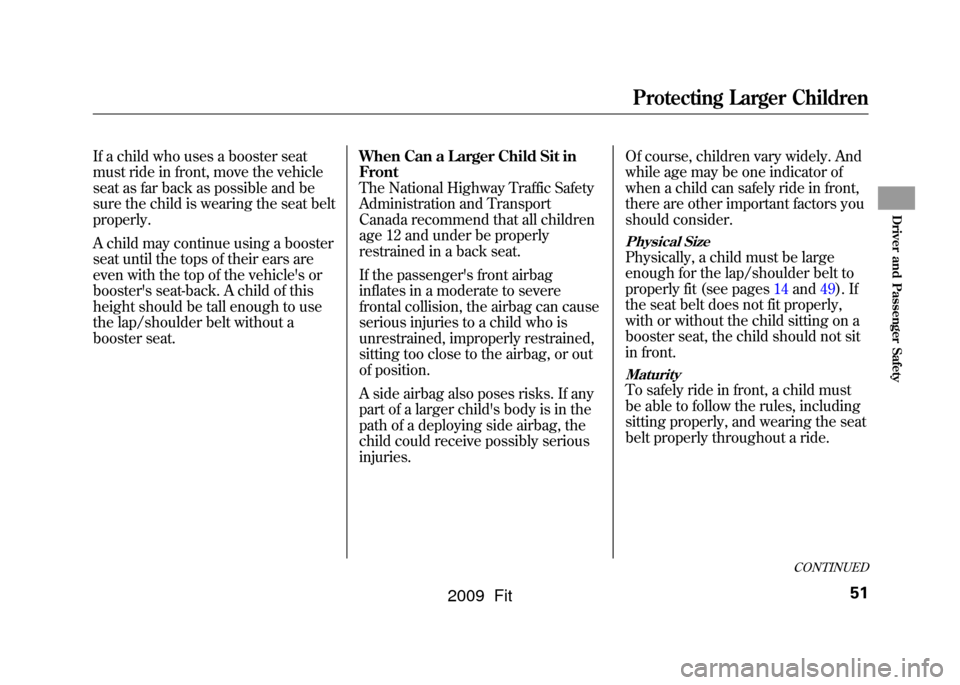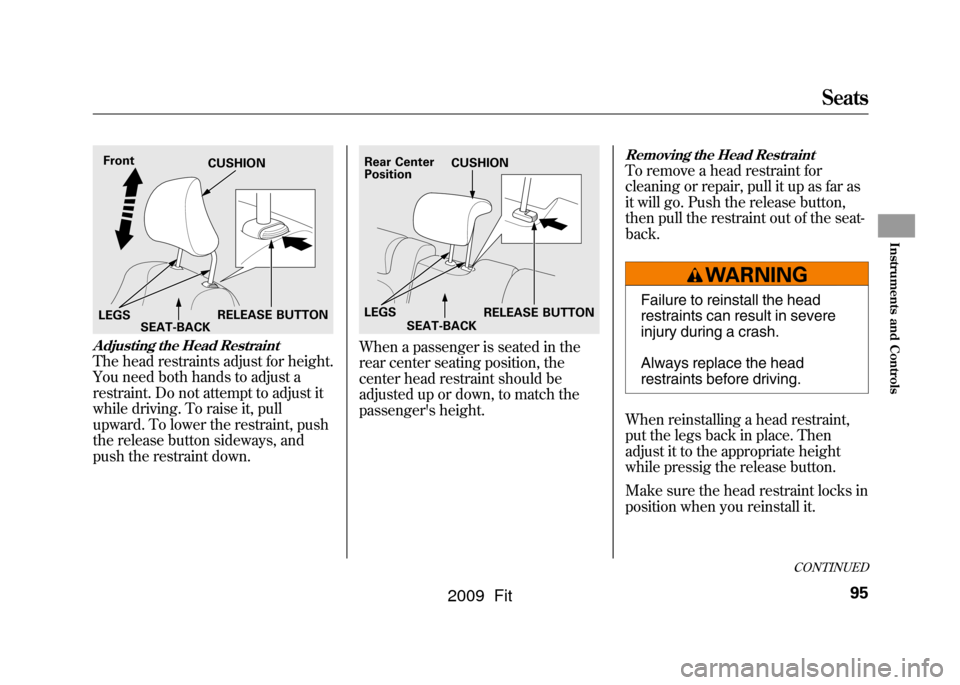Page 17 of 352

5. Fasten and Position the SeatBelts
Insert the latch plate into the buckle,
then tug on the belt to make sure the
belt is securely latched. Check that
the belt is not twisted, because a
twisted belt can cause serious
injuries in a crash.
The seat belt in the center position of
the back seat can be unlatched and
retracted to allow the back seat to be
folded up or down. This seat belt
should be latched whenever the seat-
back is in an upright position. See
page99for how to unlatch and
relatch the seat belt.
Position the lap part of the belt as low as
possible across your hips, then pull up
on the shoulder part of the belt so the
lap part fits snugly. This lets your strong
pelvic bones take the force of a crash
and reduces the chance of internal
injuries.
If necessary, pull up on the belt again to
remove any slack, then check that the
belt rests across the center of your
chest and over your shoulder.
This spreads the forces of a crash over
the strongest bones in your upper body.
Improperly positioning the seat
belts can cause serious injury
or death in a crash.
Make sure all seat belts are
properly positioned before
driving.
If the seat belt touches or crosses
your neck, or if it crosses your arm
instead of your shoulder, you need to
adjust the seat belt anchor height.
Protecting Adults and Teens14
2009 Fit
Page 18 of 352

The front seats have adjustable seat
belt anchors. To adjust the height of
an anchor, squeeze the two release
buttons, and slide the anchor up or
down as needed (it has four
positions).
Never place the shoulder portion of alap/shoulder belt under your arm or
behind your back.
This could cause
very serious injuries in a crash.
If a seat belt does not seem to work
properly, it may not protect the
occupant in a crash.
No one should sit in a seat with an
inoperative seat belt.
Using a seat
belt that is not working properly can
result in serious injury or death.
Have your dealer check the belt as
soon as possible.
See page18for additional
information about your seat belts and
how to take care of them. 6. Maintain a Proper Sitting
Position
After all occupants have adjusted
their seats and head restraints, and
put on their seat belts, it is very
important that they continue to sit
upright, well back in their seats, with
their feet on the floor, until the
vehicle is parked and the engine is
off.
Sitting improperly can increase the
chance of injury during a crash. For
example, if an occupant slouches, lies
down, turns sideways, sits forward,
leans forward or sideways, or puts
one or both feet up, the chance of
injury during a crash is greatly
increased.
RELEASE BUTTONS
CONTINUED
Protecting Adults and Teens
15
Driver and Passenger Safety
2009 Fit
Page 42 of 352

Protecting InfantsChild Seat TypeAn infant must be properly restrained
in a rear-facing, reclining child seat
until the child reaches the seat
maker's weight or height limit for the
seat, and the child is at least one year
old.
Only a rear-facing child seat provides
proper support for a baby's head,
neck, and back.Two types of seats may be used: a
seat designed exclusively for infants,
or a convertible seat used in the rear-
facing, reclining mode.
Do not put a rear-facing child seat in
a forward-facing position.
If placed
facing forward, an infant could be
very seriously injured during a
frontal collision.
Rear-facing Child Seat PlacementA rear-facing child seat can be placed
in any seating position in the back
seat, but not in the front.
Never put a
rear-facing child seat in the front seat.
If the passenger's front airbag
inflates, it can hit the back of the
child seat with enough force to kill or
seriously injure an infant.
When properly installed, a rear-
facing child seat may prevent the
driver or a front passenger from
moving their seat as far back as
recommended, or from locking their
seat-back in the desired position.
It could also interfere with proper
operation of the passenger's
advanced front airbag system.
CONTINUED
Protecting Infants and Small Children
39
Driver and Passenger Safety
2009 Fit
Page 43 of 352

In any of these situations, we
strongly recommend that you install
the child seat directly behind the
front passenger's seat, move the seat
as far forward as needed, and leave it
unoccupied. Or, you may wish to get
a smaller rear-facing child seat.
Placing a rear-facing child seat
in the front seat can result in
serious injury or death during a
collision.
Always place a rear-facing child
seat in the back seat, not the
front.Protecting Small Children
Child Seat TypeA child who is at least one year old,
and who fits within the child seat
maker's weight and height limits,
should be restrained in a forward-
facing, upright child seat.
Of the different seats available, we
recommend those that have a five-
point harness system as shown. We also recommend that a small
child use the child seat until the child
reaches the weight or height limit for
the seat.
Child Seat PlacementWe strongly recommend placing a
forward-facing child seat in a back
seat, not the front.Placing a forward-facing child seat in
the front seat of a vehicle equippedwith a passenger's airbag can be
hazardous.
If the vehicle seat is too
far forward, or the child's head is
thrown forward during a collision, an
inflating airbag can strike the child
with enough force to cause very
serious or fatal injuries.
Protecting Infants and Small Children40
2009 Fit
Page 52 of 352

When a child reaches the
recommended weight or height limit
for a forward-facing child seat, the
child should sit in a back seat on a
booster seat and wear a lap/shoulder
belt.
The following pages give instructions
on how to check proper seat belt fit,
what kind of booster seat to use if
one is needed, and important
precautions for a child who must sit
in front.
Allowing a child age 12 or under
to sit in front can result in injury
or death if the passenger's front
airbag inflates.
If a child must ride in front,
move the vehicle seat as far
back as possible, use a booster
seat if needed, have the child
sit up properly and wear the
seat belt properly.Checking Seat Belt Fit
To determine if a lap/shoulder belt
properly fits a child, have the child
put on the seat belt, then ask
yourself:
1. Does the child sit all the way back
against the seat?
2. Do the child's knees bend comfortably over the edge of the
seat?
CONTINUED
Protecting Larger Children
49
Driver and Passenger Safety
2009 Fit
Page 54 of 352

If a child who uses a booster seat
must ride in front, move the vehicle
seat as far back as possible and be
sure the child is wearing the seat belt
properly.
A child may continue using a booster
seat until the tops of their ears are
even with the top of the vehicle's or
booster's seat-back. A child of this
height should be tall enough to use
the lap/shoulder belt without a
booster seat.When Can a Larger Child Sit in
Front
The National Highway Traffic Safety
Administration and Transport
Canada recommend that all children
age 12 and under be properly
restrained in a back seat.
If the passenger's front airbag
inflates in a moderate to severe
frontal collision, the airbag can cause
serious injuries to a child who is
unrestrained, improperly restrained,
sitting too close to the airbag, or out
of position.
A side airbag also poses risks. If any
part of a larger child's body is in the
path of a deploying side airbag, the
child could receive possibly serious
injuries.Of course, children vary widely. And
while age may be one indicator of
when a child can safely ride in front,
there are other important factors you
should consider.
Physical SizePhysically, a child must be large
enough for the lap/shoulder belt to
properly fit (see pages14and49).If
the seat belt does not fit properly,
with or without the child sitting on a
booster seat, the child should not sit
in front.MaturityTo safely ride in front, a child must
be able to follow the rules, including
sitting properly, and wearing the seat
belt properly throughout a ride.
CONTINUED
Protecting Larger Children
51
Driver and Passenger Safety
2009 Fit
Page 98 of 352

Adjusting the Head RestraintThe head restraints adjust for height.
You need both hands to adjust a
restraint. Do not attempt to adjust it
while driving. To raise it, pull
upward. To lower the restraint, push
the release button sideways, and
push the restraint down.
When a passenger is seated in the
rear center seating position, the
center head restraint should be
adjusted up or down, to match the
passenger's height.
Removing the Head RestraintTo remove a head restraint for
cleaning or repair, pull it up as far as
it will go. Push the release button,
then pull the restraint out of the seat-
back.
Failure to reinstall the head
restraints can result in severe
injury during a crash.
Always replace the head
restraints before driving.
When reinstalling a head restraint,
put the legs back in place. Then
adjust it to the appropriate height
while pressig the release button.
Make sure the head restraint locks in
position when you reinstall it.
Front
RELEASE BUTTON
CUSHION
LEGS SEAT-BACK
Rear Center
Position
RELEASE BUTTON
CUSHION
LEGS SEAT-BACK
CONTINUED
Seats
95
Instruments and Controls
2009 Fit
Page 321 of 352
DimensionsLength 161.6 in (4,105 mm)
Width 66.7 in (1,695 mm)
Height 60.0 in (1,525 mm)
Wheelbase 98.4 in (2,500 mm)
Track Front 58.7 in (1,492 mm)
ꭧ1
58.1 in (1,476 mm)
ꭧ2
Rear 58.1 in (1,475mm)
ꭧ1
57.4 in (1,459 mm)
ꭧ2
ꭧ1: All models except Sport
ꭧ 2: Sport model
Weights Gross vehicle weight rating See the certification label attached to the driver's doorjamb.
Seating Capacities Total 5
Front 2
Rear 3Engine
Type Water cooled 4-stroke SOHC
i-VTEC 4-cylinder gasoline engine
Bore x Stroke 2.87 x 3.52 in
(73.0 x 89.4 mm)
Displacement 91.3 cu-in (1,497 cm
3)
Compression ratio 10.4 : 1
Spark plugs IZFR6K13 (NGK)
SKJ20DR-M13 (DENSO)
Specifications318
2009 Fit